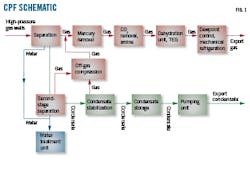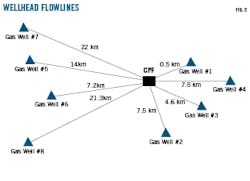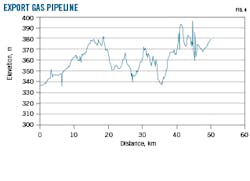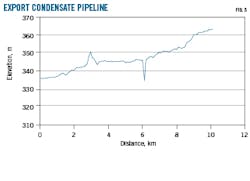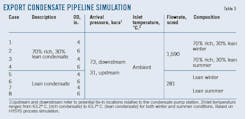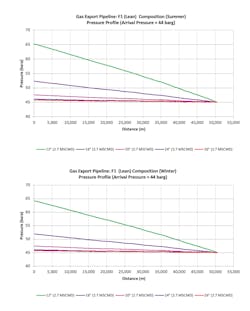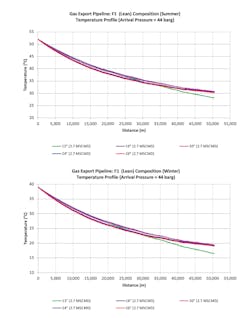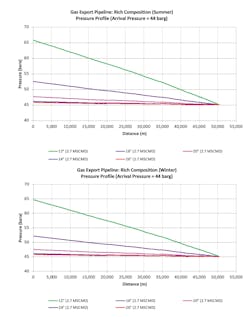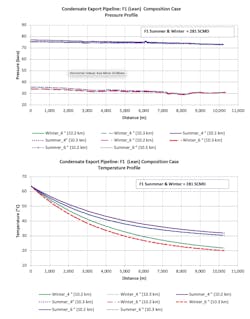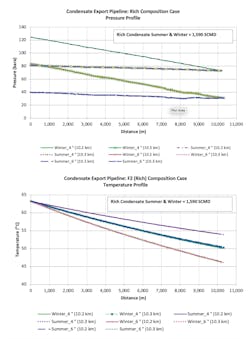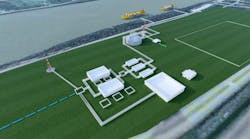Abdelaziz A. Noaman
Minia University
Minia, Egypt
Comprehensive multi-process modeling of a natural gas-condensate development—including characteristics of the produced hydrocarbons, flowlines, and processing—allows determination of export pipeline requirements.
The study underlying this article determined suitable line sizes for natural gas and export condensate pipelines in an onshore gas field development project in Algeria based on normal production and turndown conditions using steady state simulations (PIPESIM), including analysis of liquids handling issues, velocity limits for effective corrosion inhibition, and erosional velocity limits. Different gas and condensate compositions were used in the study. Aspen HYSYS Version 11 software was used to simulate the gas and condensate processing infrastructure in the gas project to generate the export gas and condensate compositions under different conditions.
A 24-in. OD line size is recommended for the export gas pipeline. A 4- and 6-in. line size meets design criteria for the export condensate pipeline. The 6-in. OD size is recommended, however, as it offers more flexibility in the event production increases.
Project description
Fig. 1 shows the major units which make up the project’s central processing facility (CPF). The gas project consists of eight wells, a gathering system, and the CPF, where the production stream from the various fields will be separated into condensate and dew-pointed gas products. The CPF includes units for liquid separation, mercury removal, CO2 removal, dehydration, and a hydrocarbon dew-pointing unit to meet export gas specifications.
The condensate separated from the gas is stabilized to meet rvp specification for export condensate. The gas will be treated in a dedicated LPG extraction plant to commercial specification required for end-user consumption. The condensate will be exported via separate export pipeline to the oil terminal.
Mercury measured up to 70 nanograms/standard cu m (ng/scm) in some well samples. Well samples contained no elemental sulfur, no wax, and no paraffin. The H2S content of the wells was zero.
Wellhead flowlines
The gas project will initially include eight wells. Fig. 2 shows the wells and the length for each wellhead flowline. Wellhead pressure of 267 bara, wellhead temperature of 50° C., and flowline pressure of 56 bar at the design flowrate of 0.425 million scm/day (mscmd, 15 MMscfd) are used. A range of compositions of different condensate-gas ratios (CGR) can be delivered by each well depending on the layer being produced.
Design capacities
The gas project is designed for production of 2.7 mscmd gas and 10,000 bo/d export condensate. Table 1 shows design flowrates for the gas wells and export gas and condensate in the gas plant.
Product specifications
Following are the gas and condensate specifications for export.
Export gas specifications:
- Water dew point = -12° C.
- Hydrocarbon dew point at 35 barg = 10° C.
- CO2 content: < 2.0 mole %.
- Pressure = 44 barg.
Export condensate requires removal of water and light hydrocarbons to meet bs&w (< 1 % v/v) and rvp (< 0.8 bar, 37.8° C.) specifications.
Processing simulation generated export gas and condensate compositions using Aspen HYSYS Version 11 software at different feed-gas compositions.1 Fig. 3 illustrates simulation of the process plant.
Pipeline profiles
Fig. 4 shows the elevation profile for the export gas pipeline from CPF to the main export trunkline. Fig. 5 does the same for the main export condensate trunkline.
Methodology
The feed-gas composition simulations in Table 1 used Aspen HYSYS software to choose the best composition for design of the CPF based on total condensate production of 10,000 bo/d and total export gas of 2.7 mscmd.
Four steady state simulation cases were developed for the selected feed compositions: a winter case and a summer case, plus a lean and rich composition for each. The varying inlet temperatures and compositions created four unique simulations.
Simulation software
HYSYS Version 11 software carried out the main process simulations in the gas plant.2 The selected physical property package for the HYSYS model developed for the gas project was the Peng-Robinson equation of state with modified interaction parameters fluid package. The binary coefficients in HYSYS were selected as recommended by the software. The export gas and condensate compositions were generated from the gas and condensate processing plant in the gas project.
Steady-state pipeline simulator PIPESIM 2019 modelled the gas and export condensate pipelines at different compositions.3
Simulation basis
PIPESIM modeled the 50.5-km export gas pipeline, from CPF to the main export gas trunkline tie-in, based on the available gas compositions for different production forecasts.
Table 2 lists the cases considered for the export gas pipeline.
PIPESIM also modelled the 10.3-km export condensate pipeline based on available condensate compositions for different production forecasts and CPF inlet temperatures.
Table 3 lists the sizing cases considered for the export condensate pipeline.
Results, discussion
Tables 4-5 summarize hydraulic results for the 50.5-km export gas pipeline for line sizes ranging from 12- to 24-in. OD at a design flowrate of 2.7 mscmd and fluid compositions (lean, and 70% rich-30% lean gas) for both summer and winter operating conditions. The arrival pressure at the main export trunkline was set at 44 barg.
Gas composition
Fig. 6 illustrates the hydraulic pressure performance curves for the export gas pipeline at lean export gas compositions in summer and winter. Fig. 7 displays the temperature profile for the export gas pipeline at lean export gas compositions in summer and winter seasons. The maximum inlet temperature of 52º C. is used for the summer case while the minimum inlet temperature of 39º C. is used for winter.
Fig. 8 shows the hydraulic pressure performance curves for the export gas pipeline at 70% rich-30% lean composition in summer and winter. Fig. 9 displays the temperature profile for the export gas pipeline at 70% rich-30% lean composition. The maximum inlet temperature of 52º C. is used for the summer case while the minimum inlet temperature of 39º C. is used for winter.
The maximum inlet pressure requirements for the export gas pipeline at the design flowrate of 2.7 mscmd and arrival pressure of 44 barg are: 65.8 bara (12-in.), 52.6 bara (16-in.), 47.7 bara (20-in.), 46.2 bara (24-in.) and 45.8 bara (26-in.). The 24- and 26-in. lines do not exceed the inlet pressure criteria of 46.5 barg (maximum) at the CPF.
For all export gas line sizes considered, erosional velocity does not exceed 90% of the erosional velocity calculated by API RP 14E and therefore satisfies the erosional velocity criterion.4 The fluid mixture velocity predicted for a 24-in. line at a flowrate of 2.7 mscmd is not excessive (maximum 2.2 m/sec).
These results led to selection of 24-in. OD pipe for the export gas pipeline.
Condensate pipeline
Tables 6-7 summarize the hydraulic results for the export condensate pipeline for two line sizes (4- and 6-in.) and two fluid compositions (lean and rich condensate) for summer and winter operating conditions.
Two routes were considered for the export condensate pipeline: CPF to condensate main trunkline, tie-in downstream of the pumping station (10.2 km) and CPF to condensate main trunkline, tie-in upstream of the pumping station (10.3 km). The arrival pressure downstream of the pumping station is 72 barg and 30 barg upstream of the pumping station.
Fig. 10 shows the hydraulic pressure performance and temperature profiles in summer and winter conditions for lean condensate it the export pipeline. Fig. 11 illustrates the hydraulic pressure performance and temperature profiles for 70% rich-30% lean condensate in summer and winter.
For the export condensate pipeline arriving downstream of the pumping station, predicted maximum inlet pressures are 125 bara (4-in.) and 81 bara (6-in.), based on a flowrate of 1,590 scmd and an arrival pressure of 72 barg at the pumping station. For the export condensate pipeline arriving upstream of the pumping station, the predicted maximum inlet pressures are 84 bara (4-in.) and 40 bara (6-in.), based on a flowrate of 1,590 scmd and an arrival pressure of 30 barg at the pumping station.
Corresponding arrival temperatures at 1,590 scmd are: 54º C. (4-in.) and 50-51º C. (6-in.). For both export condensate pipeline routes, the maximum velocity in the pipeline is less than 3 m/sec and the erosional velocity limit is not exceeded.
Either a 4- or 6-in. OD pipe would be adequate for either export condensate pipeline route. However, a 6-in. line would offer the advantage of a much lower back pressure requirement and flexibility for production increases.
A 24-in. OD line is recommended for the export gas pipeline. The maximum predicted inlet pressure at the CPF is 46.2 bara. This configuration is based on rich-gas composition and an arrival pressure of 45 bara. The maximum predicted arrival temperature for a 24-in. line is 31º C. As the gas will be dehydrated and dew-pointed at the CPF, hydrate formation is not predicted.
References
- Mokhatab, S., Poe, W.A., and Speight, J.G., “Handbook of Natural Gas Transmission and Processing,” 4th ed., Gulf Professional Publishing, Burlington, Mass., 2019.
- Aspen Tech., “Advanced Process Modeling Using HYSYS,” 2017.
- PIPESIM, “Steady-State Multiphase Flow Simulator, Schlumberger Service Co., 2019.
- American Petroleum Institute, “API Recommended Practice 14E (RP 14E),” 5th edition, 2000.
The author
Abdelaziz Noaman ([email protected]) is a principal process and flow assurance consultant and on the chemical engineering faculty of Minia University, Egypt. He holds a PhD (2018) from Minia University in process and flow assurance engineering and has 23 years of experience in the field. He is charter engineer from the UK Engineering Council, consultant engineer from the Egyptian Syndicate of Engineers, European engineer by the European Federation of National Associations, and international professional engineer by the UK Engineering Council.
